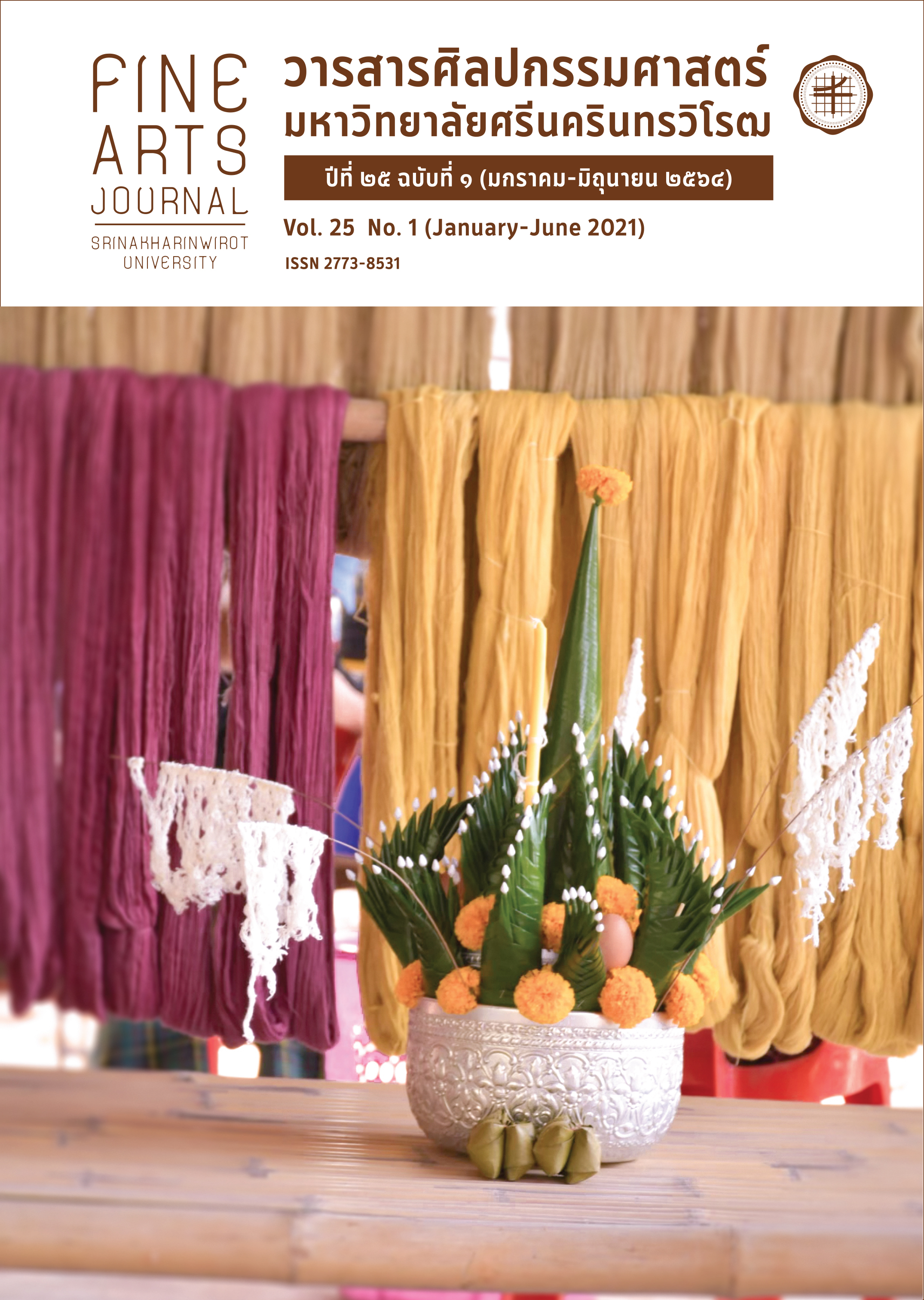A LEARNING MANAGEMENT GUIDELINE BASED ON DESIGN THINKING PROCESS FOR CREATING LOCAL PRODUCT
Keywords:
Design Thinking, Creation, Local Product, Learning ManagementAbstract
Design thinking is regarded as an initial stage of the process of creating product or innovation. The design thinking process is based on the principles of human-centered design, problem solving, creative thinking, critical thinking, and collaborative working. The process consists of five steps: 1) finding the problem from understanding the consumers 2) collecting data to define the problem 3) brainstorming 4) prototyping and 5) testing. The application of design thinking process in learning management for creating a local product can be done by applying inquiry-based learning, problem-based learning, and project-based learning because they are teaching models that emphasize developing process skills for learners. In addition, the learners need to be encouraged to have direct experience by learning in the local community or learning with experts in order to truly create an understanding of local product formats regarding utility, design practice, identity, local values, and artistic and creative skills encouragement.
Downloads
References
กุลิสรา จิตรชญาวนิช. (2562). การจัดการเรียนรู้. กรุงเทพมหานคร : สำนักพิมพ์แห่งจุฬาลงกรณ์มหาวิทยาลัย.
ณัฐพงษ์ คงประเสริฐ. (2558). การออกแบบผลิตภัณฑ์เพื่อให้ตอบสนองกับความต้องการของลูกค้า. วารสารวิศวกรรมศาสตร์ มหาวิทยาลัยศรีนครินทรวิโรฒ, 10(1), 55-65.
ธันยมัย เจียรกุล. (2557). ปัญหาและแนวทางการปรับตัวของ OTOP เพื่อพร้อมรับการเปิด AEC. วารสารนักบริหาร, 34(1), 177-191.
ปานฉัตท์ อินทร์คง. (2560). การออกแบบผลิตภัณฑ์วัฒนธรรม: แนวคิด รูปแบบ และการวิเคราะห์. กรุงเทพมหานคร: อันลิมิต พริ้นติ้ง.
ปิยะนุช ไสยกิจ. (2560). การพัฒนาต่อยอดความรู้ภูมิปัญญาท้องถิ่นสู่งานออกแบบสร้างสรรค์. วารสารวิชาการมนุษยศาสตร์และสังคมศาสตร์ มหาวิทยาลัยราชภัฏอุตรดิตถ์, 4(2), 34-46.
พิริยะ ผลพิรุฬห์. (2556). เศรษฐกิจสร้างสรรค์กับการพัฒนาประเทศไทย. วารสารเศรษฐศาสตร์ปริทรรศน์ สถาบันบัณฑิตพัฒนบริหารศาสตร์, 7(1), 1-69.
ภุชงค์ โรจน์แสงรัตน์. (2559). การพัฒนารูปแบบการสอนโดยใช้การคิดเชิงออกแบบเป็นฐานเพื่อสร้างสรรค์ผลงานที่ปรากฏอัตลักษณ์ไทยสำหรับนิสิตนักศึกษาระดับปริญญาบัณฑิต (วิทยานิพนธ์ปริญญาดุษฎีบัณฑิต). จุฬาลงกรณ์มหาวิทยาลัย, กรุงเทพมหานคร.
ศรินดา จามรมาน. (2556). รูปแบบการจัดสิ่งแวดล้อมการเรียนรู้แบบคอนสตรัคติวิสต์บนเครือข่ายด้วยกระบวนการสืบสอบเพื่อพัฒนาการคิดเชิงระบบในการออกแบบผลิตภัณฑ์ที่ยั่งยืนของนักศึกษาปริญญาตรี (วิทยานิพนธ์ปริญญาดุษฎีบัณฑิต). จุฬาลงกรณ์มหาวิทยาลัย, กรุงเทพมหานคร.
สำนักงานเลขาธิการสภาการศึกษา. (2555). การบริหารจัดการศึกษาเพื่อเปลี่ยนผ่านสู่สังคมเศรษฐกิจฐานความรู้และเชิงสร้างสรรค์. กรุงเทพมหานคร: สำนักงานเลขาธิการสภาการศึกษา.
สำนักงานส่งเสริมวิสาหกิจขนาดกลางและขนาดย่อม. (2555). ขุมทรัพย์ทางวัฒนธรรม สู่การเพิ่มมูลค่าบนเส้นทางเศรษฐกิจสร้างสรรค์. กรุงเทพมหานคร: สำนักงานส่งเสริมวิสาหกิจขนาดกลางและขนาดย่อม กระทรวงอุตสาหกรรม.
อรัญ วานิชกร. (2559). การออกแบบผลิตภัณฑ์ท้องถิ่น. กรุงเทพมหานคร : สำนักพิมพ์แห่งจุฬาลงกรณ์มหาวิทยาลัย.
Aflatoony, L., Wakkary, R., & Neustaedter, C. (2018). becoming a design thinker: Assessing the learning process of students in a secondary level design thinking course. The International Journal of Art & Design Education, 37(3), 438-453.
Asia Society. (2017). Advancing 21st century competencies in east asian education systems. Retrieved February 18, 2020, from https://asiasociety.org/education/advancing-21st-century-competencies
Brown, T. (2009). Change by design: How design thinking transforms organizations and inspires innovation. NY: Harper Business.
Camacho, M. (2018, August). An integrative model of design thinking. In 21st DMI, Academic Design Management Conference Next Wave (pp. 627-641). London, United Kingdom. Retrieved March 30, 2020, from https://www.researchgate.net/publication/326990650
Chicago Architecture Center. (2018). Discover design handbook: What is the design process? why is it helpful?. Retrieved March 17, 2020, from http://www.discoverdesign.org/handbook
Efeoglu, A., Moller, C., Serie, M., & Boer, H. (2014). Design thinking: Characteristics and promises. Paper Presented at the Conference: CINet, Nijmegen, The Netherlands. Retrieved February 11, 2019, from https://www.researchgate.net/publication/265694318
Ejsing-Duun, S., & Skovbjerg, H.M. (2019). Design as a mode of inquiry in design pedagogy and design thinking. The International Journal of Art & Design Education, 38(2), 1-16.
Elwood, K., Savenye, W., Jordan, M.E., Larson, J., & Zapata, C. (2016). Design thinking: A new construct for educators. Conference: Association for Educational Technology and Communications (AECT). Las Vegas, NV.
Fuente, J., Carconell, I., & LaPorte, M. (2019). Design thinking as a framework for teaching packaging innovation. Journal of Applied Packaging Research, 11(1), 39-69.
Hoffman, L. (2016). 10 Models for design thinking. Retrieved March 30, 2020, from https://medium.com/@elizabeth7hoffman/10-models-for-design- thinking-f6943e4ee068
IDEO. (2013). Design thinking for educators. Retrieved March 30, 2020, from https://designthinkingforeducators.com
Kovatcheva, E., Campos, J.A., Roman, J.L, Dimitrov, G.P., & Petrova, P. (2019). Design
thinking in higher education. Proceeding of EDULEARN19 Conference, July 1st - 3rd, Palma, Mallorca, Spain.
Lor, R. (2017). Design thinking in education: A critical review of literature. Paper presented at the Asian Conference on Education and Psychology, May 24- 26, Bangkok, Thailand. Retrieved March 30, 2020, from https://www.researchgate.net/publication/324684320
Sarasuk, K.P. (2018). How to apply design thinking process as a tool for creating a prototype bag from Tai-lue handwoven fabric remnants. Veridian E- Journal, Silpakorn University, 11(4), 865-878.
Zande, R.V. (2010). Teaching design education for cultural, pedagogical, and economic aims. Studies in Art Education, 51(3), 248-261.






